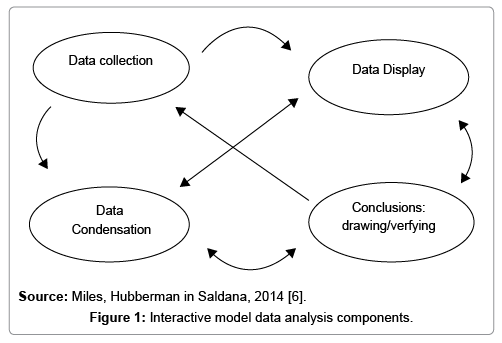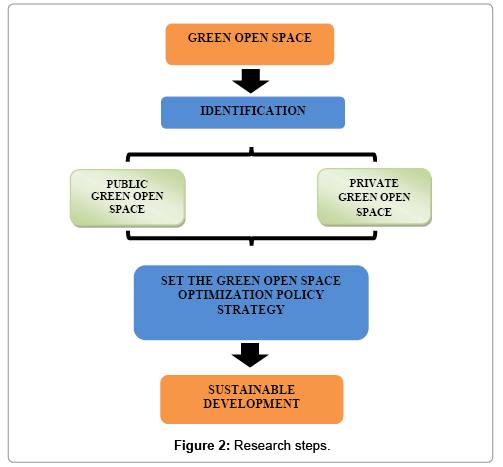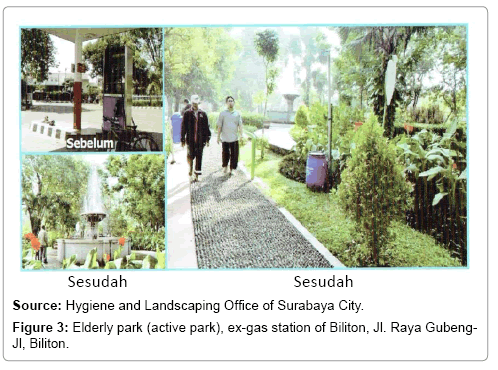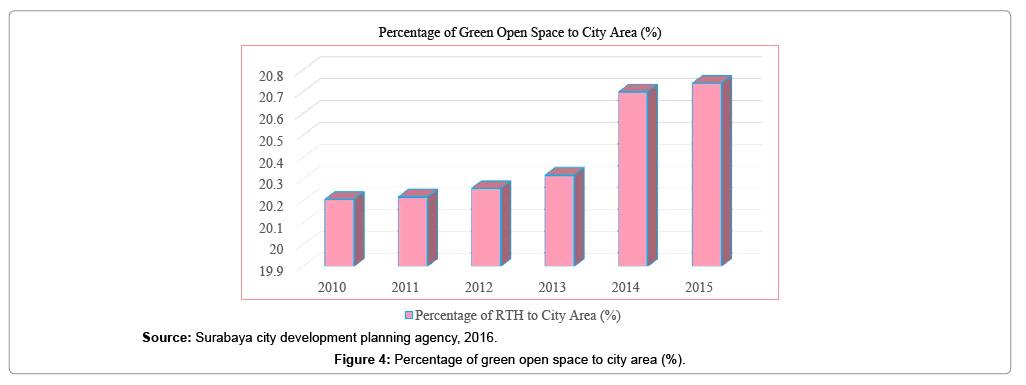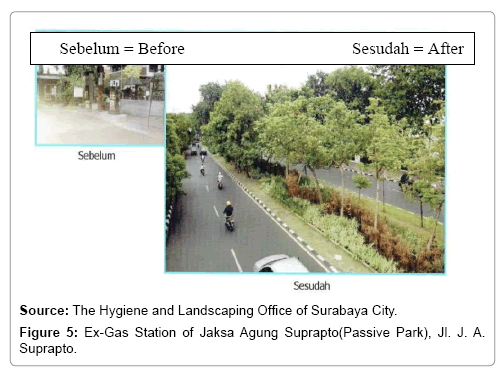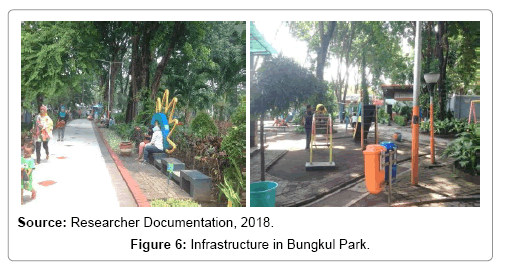The Role of the Surabaya City Government in Optimizing Green Open Space
Received: 17-Sep-2018 / Accepted Date: 28-Sep-2018 / Published Date: 05-Oct-2018
Abstract
Public Green Open Space is one of the important components for managing the city in order to realize the mandate of Law Number 26 of 2007 on Spatial Planning that is the proportion of public green open space and private green open spaces in the city area at least 20 (twenty) percent of public green open spaces and 10 (ten) percent of private green open spaces of the city area. The Surabaya City Government in providing Public Green Open Space and Private Green Open Space continues to carry out their duties to keep improving the quality and quantity of Public Green Open Space and Private Green Open Space in order to meet the necessity of urban greening so that the environmental development keep running. Therefore in this study, the researchers choose the establishment of a policy strategy carried out by the Surabaya City Government through the Hygiene and Landscaping Office in optimizing Public Green Open Space and Private Green Open Space based on sustainable development in the city of Surabaya. This study aims to: (1) describe the optimization of Public Green Open Space and Private Green Open Space in the city of Surabaya, (2) to describe the supporting and inhibiting factors faced by the Surabaya city government. This research is a qualitative descriptive study. Data sources used are primary data and secondary data. The techniques of data collection are by interviews, observations, documentation and literature studies. The results of the research showed that the development of parks and green lanes in almost all areas of Surabaya has increased in addition to pursuing a target of 30% green open space and the development is more conceptual and controlled. This is done by optimizing the land which is destined for green open space. To achieve success there will be several groups of human resources who play a role as supporters, namely the community, bureaucrats, the private sector, smart people, community leaders, customs, religion, academics, and Non-Governmental Organization (NGO).
Keywords: Green open spaces; Public; Private
Introduction
Development Administration can be interpreted as an effort control process (administration) carried out by the State/Government to realize planned growth towards a condition that is considered better and progress in various aspects of the nation’s life. According to Siagian, development administration is an effort or series effort of planned growth and change carried out consciously by a Nation, State and Government towards modernity in the context of nation building. Development is often formulated as a planned change from a national situation to another national situation which is considered to be higher, essentially time-specific: situated in time and place (development that looks at the situation and place). A country will always strive to make a comprehensive development on the aspects of the life of society and nation for the demands of an increasingly-modern era that continuous to develop in all fields. In carrying out a series of development activities, community involvement is needed to support the government’s duties in realizing the goals to be achieved.
The duties of the Central and Regional Governments are a basis for carrying out National Development. In the era of regional autonomy, there is devolution of authority from the Central Government to the Regional Government in carrying out development activities. In accordance with Law No. 32 of 2004 (Regional Autonomy) [1] article 1 paragraph 5, describes the Regional Autonomy is the right, authority and obligation of the autonomous region to regulate and manage their own affairs and the interests of the local community in accordance with the Laws. This is an opportunity for the District/City Government to be able to plan and manage development in the region, including in managing financial resources to finance the implementation of Regional Autonomy activities.
The city of Surabaya as part of the Autonomous Region has the right to balance the urban ecosystem for the improvement of the urban aesthetics. In balancing the urban ecosystem can be obtained by exploring the potential that exists in the city of Surabaya, one of which is to utilize the potential in the environmental sector in accordance with the Law of the Republic of Indonesia Number 32 of 2009 Article 57 on Protection and Management of the Environment [2] which explains:
Maintenance of the environment is carried out through efforts to reserve the natural resources; reserving of the natural resources includes natural resources that can be managed in a long term and at certain times in accordance with necessity. To carry out reserves of the natural resources, the government, provincial government, or district/ city government and individuals can build Green Open Space (Indonesia: Ruang Terbuka Hijau (RTH)) at least 30% of the island area.
In the Law of the Republic of Indonesia Number 26 of 2007 on Spatial Planning explains that green open space is an elongated area/ lane and/or clustered, which its use is more open, a place to grow plants, both natural and intentionally grown [3]. Green open spaces as intended consist of public green open spaces and private green open spaces. Proportion of the Green Open Space covering 20% Public Green Open Space and 10% Private Green Open Space.
The Green Open Space above will be very useful if the procurement of Public Green Open Space (RTP) is carried out optimally. Before all land area are transformed into multi-storey buildings (shophouses, malls, hotels, etc.) which will cause the availability of green open space with the functions and benefits that are needed by the local people to decrease, until finally there will no land for the procurement of the green open space, and the society who will receive the impact. This becomes serious concern for the government in managing its city by studying and managing green open space properly and as a whole and parallel to the development of Surabaya in supporting sustainable development. Regulatory components that must be considered in the provision and management of green open spaces to be more optimal are technical arrangements and organizing arrangements. Technical arrangements include; standard necessity, and land allocation of urban green open space. Organizational arrangements include green open space management (planning, implementation, utilization and control), institutional, financing, and community participation. These components have a very great influence in the presence of green open space.
In achieving the optimal green open space carried out by the Surabaya City Government, which has been explained in the 2016-2021 Strategic Plan (Indonesia: RENSTRA) of the Hygiene and Landscaping Office of Surabaya City is through the green open space management program which includes green open space arrangement, maintenance and procurement of parks facilities and green lanes, and Maintenance and Procurement of Recreational Park Facilities and Infrastructure [4]. This is reinforced by the existence of the Regional Medium Term Development Plan (RPJMD) in 2016-2021 in Surabaya City, where the aims of the green open space management program is to ensure environmental sustainability. In achieving the aims the Hygiene and Landscaping Office of Surabaya City formulate policies and programs in accordance with their authority, duties and functions. In achieving the goal of the Green Open Space (RTH) management program, the role of the Surabaya City Government is needed so that the program is achieved in accordance with what has been targeted.
Problem Formulation
Based on the background stated above, the author formulates the following problems:
1. How to Optimize Public Green Open Space and Private Green Open Space in Surabaya City based on Sustainable Development?
2. What is the Role of the Surabaya City Government in improving the Optimization of Public Green Open Space and Private Green Open Space based on Sustainable Development?
Research Purposes
The research conducted on the Surabaya City Government in optimizing Public Green Open Space and Private Green Open Space based on Sustainable Development was carried out on the basis of researchers’ curiosity towards the planning policy of the Surabaya City Government in Optimizing Public Green Open Space and Private Green Open Space. Specifically, the purposes of this research are:
1. To find out how to Optimize Public Green Open Space and Private Green Open Space in Surabaya City based on Sustainable Development?
2. To find out the role of the Surabaya City Government in Optimizing Public Green Open Space and Private Green Open Space in Surabaya City?
Benefits of Research
In accordance with the research purposes described earlier, the research conducted by the author on the Optimization of Public Green Open Space (RTH) and Private Green Open Space based on Sustainable Development in the Surabaya City Government is expected to be able to provide a useful contribution to all parties related. Both for the government and the community and can be used as learning material and rationale regarding Optimization of Public Green Open Space (RTH) and Private Green Open Space (RTH) so as to be able to realize an optimal Public Green Open Space and Private Green Open Space based on Sustainable Development.
Research Urgency
The city of Surabaya, as part of the Autonomous Region, has the right to balance the urban ecosystem for the improvement of the urban aesthetics. In balancing the urban ecosystem can be obtained by exploring the potential that exists in Surabaya City, one of which is to utilize the potential in the environmental sector in accordance with the Law of the Republic of Indonesia Number 32 of 2009 Article 57 on Protection and Management of the Environment.
Before all land is transformed into multi-storey buildings (shophouses, malls, hotels) that will cause the availability of green open space with the functions and benefits that are needed by the local people are on the wane, that eventually there will be no land for the procurement of Green Open Space, as well as Green Open Space in the houses development and the communities who will receive the impact. This becomes a serious concern of the government in managing its city by studying and managing Green Open Space properly and becoming a unity and parallel to the development of the city in supporting sustainable development.
Research Methods
Research design
This research is conducted in order to find the right strategy for the Surabaya City Development Planning Agency and the Hygiene and Landscaping Office of Surabaya City in optimizing green open spaces to support sustainable development.
This research uses a qualitative approach. Through qualitative methods in the early stages, the researchers conduct exploration, and then collect in-depth data about all available green open spaces and their uses.
The aim of the researchers is to get data to describe the condition or phenomenon comprehensively so that it can establish the strategy of the Surabaya City Development Planning Agency and the Hygiene and Landscaping Office of Surabaya City in optimizing green open spaces.
Data and data sources
In this study it uses a qualitative approach, instead of using questionnaire, the researchers use the interview method in primary data collection, so the data source in this study is called an informant. Whereas for secondary data, the researchers come directly to the research site, specifically all available green open spaces, according to the researchers, this could provide secondary data in this study as a support.
Data collection and analysis techniques
Data collection techniques are the most strategic step in research, since the main purpose of the research is to get data. Without knowing data collection techniques, the researchers will not get data that meets the standards of specified data. Sugiyono [5] distinguishes data collection techniques into four parts, namely observation, interview, documentation, and a combination of all three (triangulation).
In this study, the researchers used qualitative data analysis, based on interactive models by Miles and Huberman [6]. The components of analysis in this interactive model are described as follows (Figure 1):
In the picture shows four activities, starting from the data collection, data condensation, data display, conclusions: drawing/verifying.
Research steps
The Research steps are illustrated in Figure 2.
Results and Discussion
The optimization of green open space (RTH)
In Indonesian Language Dictionary, WJS Poerdwadarminta stated that, Optimization is the results achieved in accordance with the hopes, so optimization is the achievement of results in accordance with expectations effectively and efficiently. Much optimization is also defined as a measure in which all needs can be met from the activities carried out. According to Winardi [7], Optimization is a measure that causes the achievement of goals while if viewed from the point of view of effort, Optimization is an effort to maximize activities so as to realize the expected or desired benefits. From the description it is known that optimization can only be realized if in its realization is effectively and efficiently. In the implementation of organization, the goal is always directed to achieve results effectively and efficiently in order to be optimal.
There needs to be a time limit and determination of procedures for achieving optimization. Success or failure of the implementation process according to Edward, quoted by Abdullah [8] is influenced by factors which are the most important requirements for the success of an implementation process. These factors are:
1. Communication, is a program that can be implemented properly if it is clear to the implementers. This concerns on the process of delivering information, clarity of information and consistency of the information delivered;
2. Resources, in this case include four components, they are the fulfillment of staff numbers and the quality, information needed for decision making or sufficient authority to carry out dutiess as responsibilities and facilities needed in implementation;
3. Disposition, attitude and commitment to the implementation of the program, especially from those who are implementing the program. Based on the understanding of the concepts and theories above, the researcher can conclude that optimization is a process of implementing a program.
In the implementation of the optimization of Green Open Space the Law No.26 of 2007 on Spatial Planning [3], urban spatial planning must include a plan for the provision and use of green open spaces with at least 30% of the city area. The function of green open space is as the lungs of the city. The existence of a supporting factor in the availability of Open Space is very important (Rosdiana, 2013: 25-26) reveals the essential elements of supporting factors are human resources and institutions that play a role in the success of the development of Green Open Space. The Human Resource elements that plays a role consist of four target group:
1. Community elements are the main element or driving element
2. Bureaucrat elements, bureaucrats must be able to reposition themselves as executors of development
3. Private elements, companies in urban areas must be willing to play a role in supporting the Green City Development Program
4. Supporting elements, this supporting element consists of: smart people, community leaders, traditional leaders, religious leaders, universities and Non-Governmental Organization.
The four elements of the target group related to the Green Open Space (RTH) each has a very important role in the optimization of Green Open Space (RTH).
The strategy of the development planning agency of Surabaya city and the hygiene and landscaping office of Surabaya city in optimizing green open space
From the results of discussions with the City Government on Wednesday, May 9, 2018, the optimization of public green open spaces in Surabaya City involved stakeholders in the Regional Work Unit (Indonesia: SKPD) within the Surabaya City Government. Optimizing green open space in the city of Surabaya is very necessary to be maintained. Trying to expand public green space, increasing public awareness of the importance of green open space is also needed to maintain and increase green space in the city of Surabaya. In planning the optimization of public green open spaces the Surabaya City Government is guided by the Surabaya City Regulation Number 7 of 2002 on Management of Green Open Space [9].
At present the Surabaya City Hygiene and Landscaping Office and the Surabaya City Development Planning Agency are still trying to maintain the optimization and add to the public Green Open Space in the City of Surabaya. One of them is by continuing to improve planning and coordination among stakeholders by developing city parks and adding green lanes.
To achieve all the optimization requires a strategic planning carried out by an organization to determine the strategy or direction, as well as to make a decision to allocate funds (including asset and human resources). In achieving this, it is necessary to have a good role and cooperation from the government and the community to equally realize the importance of green open space and equally play an active role in maintaining the optimization of public green space in the city of Surabaya. Creating an environmentally friendly city must be a common concern, not only Surabaya City Government and the central government, but all citizens of Surabaya City.
The Development Planning Agency and the Hygiene and Landscaping Office of Surabaya City in doing their duties and authorities do not work alone but collaborate with other related Regional Work Units instead to create a green open space and maintain the optimization of the green open space of Surabaya City which has now reached nearly 30% [10]. The related Regional Work Units are the Surabaya City Development Planning Agency, the Hygiene and Landscaping Office, the Agriculture Office, the Building and Land Management Office, Creative Works and Spatial Planning Office, and the Youth and Sports Office. The Stakeholders carry out their main duties and functions and mutually cooperate and coordinate with all stakeholders.
In retrieving research data, the researchers get a yearly growth table regarding the area of green open space in the Surabaya City Government as read in Figure 3.
From the table above it appears that the Surabaya City Government has carried out a green movement, and a number of achievements on the efforts made by the Surabaya City Government together with the citizens are reaping the results. Surabaya has become a city full of achievements at regional and national levels. As a metropolis that faces challenges in environmental issues, the City Government holds various programs to stimulate greening such as Green and Clean Competition among villages, Community-based Waste Management, Mangrove Conservation. Urban environmental management in the city of Surabaya can be an example of a green open space management policy that can enrich urban science management in general and green open space management in particular. In this study revealed the implementation of green open space policies conducted by the City of Surabaya in managing green open space as an effort to preserve the environment.
The development of green open space in Surabaya City
The development of green open spaces (RTH) of parks and city green lanes has experienced rapid development in line with the interview results conducted with Ms. Vieka Ariestyani revealing that the development of parks and green lanes in the city of Surabaya has increased in addition to pursuing a 30% target, Green Open Space (RTH) and its development is more conceptual and controlled. This is done by optimizing the land destined for Green Open Space (RTH). In addition, the development was carried out evenly in almost all areas of Surabaya.
This is also confirmed in the 2016-2021 Regional Medium Term Development Plan of the Hygiene and Landscaping Office of Surabaya city related to the green open space program and City Landscaping on the target made, i.e. the optimization of the function of Green Open Space. From the basic year 2013 the area of green open space managed by the Hygiene and Landscaping Office was 16.13% and in the following year the target was increased. The target realization was successfully implemented in 2014 with a target of 20.27% and the realization was 25.31% and increased in 2016 to 30% and the realization in that year was in accordance with the target set. In 2016 the target was reached 30% in accordance with the provisions of Law No. 26 of 2007 on Spatial Planning [3].
The improvement of parks and green lanes is also seen in the achievement of green open spaces managed by Hygiene and Landscaping Office of Surabaya city. Since 2010 the area of parks and city green lanes has continued to increase, from 2011 to 2013 the park areas and green lanes is 69.70 Ha, and in 2016 covers an area of 101.66 Ha [11]. Also with other Green Open Spaces managed by the Hygiene and Landscaping Office (Indonesia: DKP), i.e. the sports field, grave, and verification (handover of assets) carried out since 2010 and have increased. Up to 2017 the overall percentage of green open space managed by the Hygiene and Landscaping Office (DKP) for the area of Surabaya City in 2013 which was originally a 16% area continued to increase in 2017 to 30%.
The spread of the park and the city green lanes comprehensively starting from Central, North, South, East and West Surabaya each have a city park and green lane to balance the ongoing development with its environment. The development of parks and green lanes is marked by the revitalization of several parks and the development of new parks in the land allocation for green open space. The step taken by the Surabaya city government to add the green open space is by returning the land allocation which previously contained buildings and then returned to a green open space area. From the government effort, 13 gas stations on the green open space allocation area were returned to their function by building a number of city parks.
The development of green open space continues to increase both in quantity and quality. In quantity, there are hundreds of parks and green lanes in Surabaya city which are spread in various regions in Surabaya city, which used to be more in the city centers now spread to suburban areas so that every region in Surabaya city can meet the necessity of the green open space. This is in accordance with the directives of Law No. 26 of 2007, i.e. each city is required to meet the green open space of 30%. Thus, Surabaya City has been able to provide 30% of various types of green open space, of which 30% are in the form of parks and city green lanes. In quality, parks and green lanes are increasing and the results can be seen today and need to be maintained continuously. The development of green open space of Surabaya City Government at present, especially the Hygiene and Landscaping Office able to manages the park and the green lane well, in recent times its development has technically led to more conceptual and controlled parks and green lanes with thematic models.
The green open space arrangement of Surabaya City government
Green Open Space is a green open space that is owned and managed by the regional government of Surabaya city that is used for the benefit of the society generally. Optimization of green open space is included in the green open space management program in accordance with the 2016-2021 Strategic Plan (Indonesia: RENSTRA) of the Hygiene and Landscaping Office of Surabaya City with the target set, it is increasing the green open space and the function of the park. The park which is managed by the Hygiene and Landscaping Office of Surabaya City consists of 2 types of parks [12], i.e. active parks and passive parks. An active park is a park in which a park user can build their activities, so that the park users actively able to use the facilities in it where visitors or park users can move freely in the park area. Passive Park is a park that can only be enjoyed through its visual beauty and longing as an accentuation to attract attention, without holding activities inside, such as a park in the middle of an intersection, and a park in the street.
The improvement efforts made are listed in the Green Open Space Management Program in accordance with the 2016-2021 Strategic Plan (RENSTRA) of the Hygiene and Landscaping Office of Surabaya City through Green Open Space Management activities [13]. Based on the 2016-2021 Medium Term Regional Development Plan (Indonesia: RPJMD) of Surabaya City, the benchmark of success of this program is the increasing percentage of green open space that functions optimally towards the total area of green open space. To realize an increase in green open space and park functions, the optimization of public green open spaces in Surabaya city needs to be done. Therefore, the green open space arrangement is one of the main activities of the program. As stated by Mr. Guntoro as Coordinator of Planning and Supervision of the Park Area.
Optimizing green open space is the target of the green space management program. Activities to achieve these goals, one of which is the green open space arrangement. So the green open space management activities are focused on revitalizing, carrying out new developments and arranging new areas. The revitalization is like returning the function of land owned by the government and allocation for green open spaces. Our achievements in 2015 have now managed to restore the function of 13 gas stations destined for green open spaces, in the form of parks, both active parks and passive parks. (Result of the interviews conducted on March 28, 2018, at 10.00 at the Office of Hygiene and Landscaping of Surabaya City).
From the statement delivered, in achieving an increase in the area of green open space in Surabaya, the Hygiene and Landscaping Office of Surabaya City has various policies from the green open space management program, one of which is the arrangement of green open space by revitalizing to return the function of green land which previously used as gas stations ( The Fuel Filling Station for the Public) becomes a land with the initial function of a public green open space in the form of parks, both active parks and passive parks.
The Surabaya City Government had succeeded in restoring the function of 13 gas stations destined for green open spaces into parks in Surabaya city, both active parks and passive parks. By the success of restoring the function of this public green open space, it will increase the area of Green Open Space in Surabaya city in accordance with the objective of green open space arrangement activities. Some ex-gas station parks in both active parks and passive parks can be seen in the following pictures (Figures 4 and 5).
Based on the explanation and description above, it can be seen that the Hygiene and Landscaping Office is guided by the Strategic Plan of 2016-2021, the effort being made is the green open space arrangement. The Strategic Plan consists of revitalization activities by returning the function of land allocation for green open spaces. In addition to revitalization, the arrangement of green open spaces is also focused on developing and arranging new areas. As stated by Mrs. Vika Ariestyani as Staff of General and Personnel Division of The Hygiene and Landscaping Office is; “Green Open Space Arrangement is not just revitalization activities, but we also do the development and arrangement of new Green Open Space areas which the development targets are guided by the determined Regional Medium Term Development Plan. The development of the new area of green open space is built in zones that are destined for green open spaces in Surabaya city. Now in Surabaya there are 287 passive parks and 129 active parks. The development is not only located in the center of the city, but spread evenly throughout Surabaya city. (Results of the interviews conducted on April 18th, 2018, at 11:20 in the office of Surabaya City Hygiene and Landscaping Office).
From the statement delivered, spatial planning activities which included in this green open space management program have activities focused inside, i.e. revitalization, new development and new area arrangement. In carrying out the development and arrangement of the new area, the Hygiene and Landscaping Office is guided by the number of targets determined by the Medium Term Development Plan of Surabaya City which has determined the number of developments and zones allocation for green open spaces. The development of Green Open Space continues to increase both in quantity and quality. In quantity, there are hundreds of parks and green lanes in the city of Surabaya, which spread in various regions in Surabaya, which used to be more in the city centers and now spreading to suburban areas so every region in Surabaya can meet the necessity of Green Open Space and in accordance with the direction of Law No. 26 of 2007 where each city must meet at least 30% Green Open Space, then Surabaya is able to provide Green Open Space a 30% of various types of green open space in the form of parks and green lanes. So far in Surabaya city there are 287 passive parks and 129 active parks (Surabaya City Government Profile Book, 2017) [14].
The Optimization of the green open space managed by the Hygiene and Landscaping Office of Surabaya City by greening the city green lane, as well as the routine revitalization of the city park in the management of the park, such as maintenance and supervision, besides the officers also coordinates with other officers in meeting the necessity of park facilities and infrastructures, so the quality of the park green open spaces and green lanes is increasing.
The Green open spaces has spread comprehensively starting from Central, North, South, East and West Surabaya all have parks and green lanes city to balance the ongoing development with the environment. In quality, the green open space is increasing and the results can be seen today to be kept and maintained. Therefore, the Hygiene and Landscaping Office has several supporting programs contained in the 2016-2021 Strategic Plan, one of which is a Green Open Space Management program through the activities of the Maintenance and Procurement of Recreational Park Infrastructure. The Recreational Park is a term for an active park. An active park is a park in which park users can build their activities, so that park users actively use the facilities inside where visitors or park users can do their activities freely in the park area. As stated by Mr. Aditya as the Secretary of the Hygiene and Landscaping Office of Surabaya City gave the following statement:
“For supporters of green open space optimization in Surabaya city [15], one of the government support in optimization is through maintenance activities and procurement of recreational park infrastructure. The recreational park infrastructure (active park) itself is the existence of supporting facilities that supports means to meet the visitors’ need to enjoy the park. For example, the Bungkul Park seemed to have complete infrastructure, such as game facilities, lots of seats, toilets and guardhouse.” (Result of the interviews on Wednesday, April 18th, 2018 at 09:45 at the Hygiene and Landscaping Office of Surabaya City).
From the statement delivered, it can be seen that the Hygiene and Landscaping Office is guided by the 2016-2021 Strategic Plan (RENSTRA) in supporting the Green Open Space Management program through the activities of the Maintenance and Procurement of Recreational Park Infrastructure. The effort is to provide infrastructure facilities in an active park in Surabaya city, to meet the park visitors’ need in enjoying the park and feeling comfortable. The Infrastructures in some of Surabaya’s active parks can be shown by the results of a survey by researchers in the form of documentation on April 18th, 2018 (Figure 6).
Based on the interviews and documentation results it can be seen that by the procurement of recreational park infrastructures (active parks) providing comfort to the people of Surabaya, especially active park visitors. So that park users can actively use the facilities in where visitors or park users can do their activities freely in the park area. Activities to procure infrastructure at this recreation park also need to be carried out maintenance, both from the infrastructure facilities and condition of the park itself must be maintained properly. Efforts made by the Hygiene and Landscaping Office are the maintenance activities included in the Maintenance and Procurement of Recreational Park Infrastructure.
Conclusion
Referring to the results of the study by knowing, describing and analyzing the role of the Surabaya City Government in optimizing green open space, the conclusions can be obtained as follows:
• The City Government plays a role in Optimizing Green Open Space in Surabaya city by initiating the implementation of Green Open Space Optimization through a Green Open Space Management program that has been regulated in the 2016-2021 Strategic Plan of The Hygiene and Landscaping Office of Surabaya City include activities of Green Open Space Arrangement, Maintenance and Procurement of Park and Green Lane Facilities, as well as Recreational Parks.
• The Government strives to increase the participation of the Surabaya city community in the management of green open spaces, because the people themselves who feel the direct impact of the green open space which are improved incessantly in accordance with the targets regulated in the 2016-2021 Strategic Plan of The Hygiene and Landscaping Office of Surabaya City.
Acknowledgement
This research was conducted by researchers at the Faculty of Law, Wisnuwardhana University, Malang. Researchers received support from the Beginner Lecturer Research Scheme (PDP) in 2018, Directorate of Research and Development, Ministry of Research and Higher Education of the Republic of Indonesia.
References
- Law of the Republic of Indonesia Number 32 Year 2009 Concerning Protection and Management of Environment.
- Regional Medium Term Development Plan of Surabaya City Year 2015-2020, Development Planning Agency of Surabaya City, Surabaya City.
- Sugiyono (2012) Educational Research Methods, Quantitative, Qualitative and R&D Approaches, Alfabeta, Bandung.
- Miles BM, Hubberman AM, Saldana J (2014) Qualitative Data Analysis. SAGE Publications, Inc. United States of America.
- Winardi (1999) Introduction to System Theory and System Analysis. Mandar Maju, Bandung.
- Fauzi A (2004) Economics of Natural Resources and the Environment. PT Gramedia Pustaka Utama, Jakarta.
- Regional Regulation of Surabaya City No. 7 Year 2002 on Management of Green Open Space.
- Joga N, Ismaun I (2011) 30% Green Open Space! Green City Resolution, PT Gramedia Pustaka Utama. Jakarta.
- Law No. 54 Year 2010 on Stages, Regarding Procedures for Preparation, Control, and Evaluation of the Implementation of Regional Development Plans.
- Budihardjo E (1983) Architecture and Cities in Indonesia. Alumni, Bandung.
- Minister Regulation No.1 Year 2007 on Green Open Space Spatial Planning for Urban Areas.
- Minister of Home Affairs Regulation No. 1 Year 2007 on Types of Green Open Space. Area of Green Open Space in Surabaya City. The Development Planning Agency of Surabaya City, Surabaya City.
- Regional Regulation of Surabaya City No. 3 Year 2007 on the Surabaya City Spatial Plan.
Citation: Suryaningsih, Werdiningsih E, Chrisdanty F (2018) The Role of the Surabaya City Government in Optimizing Green Open Space. J Civil Legal Sci 7: 248. DOI:
Copyright: © 2018 Suryaningsih, et al. This is an open-access article distributed under the terms of the Creative Commons Attribution License, which permits unrestricted use, distribution, and reproduction in any medium, provided the original author and source are credited.
Select your language of interest to view the total content in your interested language
Share This Article
Recommended Journals
Open Access Journals
Article Usage
- Total views: 4498
- [From(publication date): 0-2018 - Dec 20, 2025]
- Breakdown by view type
- HTML page views: 3614
- PDF downloads: 884

